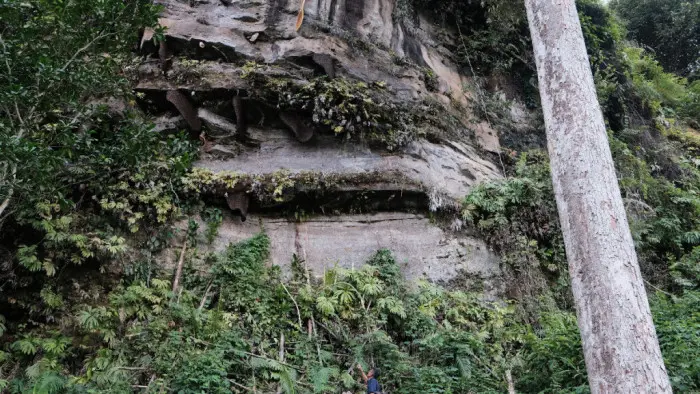This story excerpt was translated from bahasa Indonesia. To read the original story in full, visit Sumbarsatu. You may also view the original story on the Rainforest Journalism Fund website. Our website is available in English, Spanish, bahasa Indonesia, French, and Portuguese.

SIJUNJUNG, Indonesia—The period 2011-2016 saw forest loss of around 15,000 hectares per year in West Sumatra. And the 2017-2021 period was below 15,000 hectares per year. This condition has an impact on the decline of forest bee habitat and sialang honey—as happened in Nagari Latang, Sijunjung Regency. In fact, forest bees or Apis dorsata are superior pollinators. More than 80 percent of plants need pollination.
Fifteen forest beehives of various sizes on a rocky cliff. They were blackish brown in color. Their distance from the ground ranges from 20-30 meters. Sometimes, a colony of worker forest bees fly from one of the hives to hunt for flower nectar. Other times, a colony of flying bees enters the hive to collect honey.

As a nonprofit journalism organization, we depend on your support to fund journalism covering underreported issues around the world. Donate any amount today to become a Pulitzer Center Champion and receive exclusive benefits!

The rocky cliff is about 50 meters high; there is a basin that is enough to take shelter when it rains, located on the edge of the district road. The area is called Sialang, a natural gateway to Nagari Latang from Nagari Lubuk Tarok, Lubuk Tarok District, Sijunjung Regency, West Sumatra.
Nagari Latang, covering an area of 20.80 square kilometers, or 11.09 percent of the Lubuk Tarok sub-district area (19,233 hectares), is a forest bee or sialang honey farming village. The bee species is Apis dorsata. The honey farmer is called tukang sialang.












